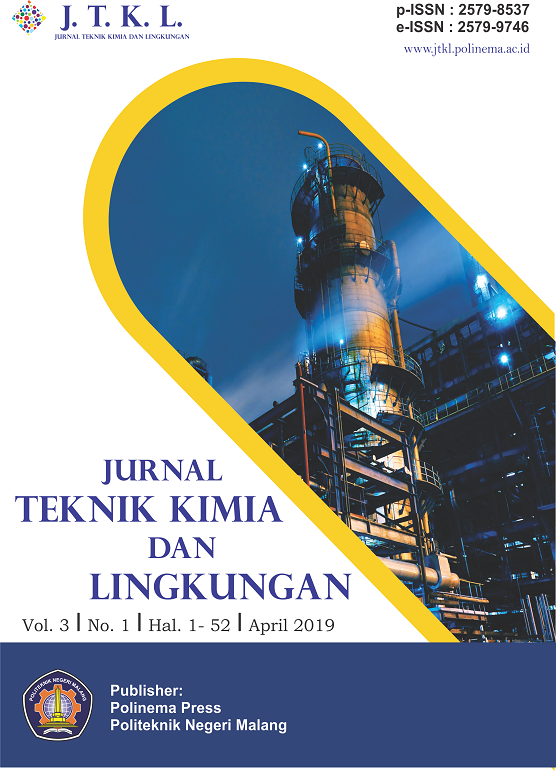Produksi Crude Selulase dari Limbah Kayu Mahoni Menggunakan Phanerochaete chrysosporium
DOI:
https://doi.org/10.33795/jtkl.v3i1.86%20Keywords:
cellulose, crude cellulose, lignocellulose, mahogany, Phanerochaete chrysosporiumAbstract
Limbah kayu mahoni dapat dikategorikan sebagai limbah lignoselulosa yang dapat dimanfaatkan sebagai bahan baku pembuatan biofuel, seperti bioetanol. Selulosa pada limbah kayu mahoni dapat dimanfaatkan sebagai bahan baku produksi crude selulase dengan bantuan kapang Phanerochaete chrysosporium. Crude selulase yang dihasilkan memiliki nilai ekonomis yang tinggi dan dapat dimanfaatkan dalam berbagai bidang. Tujuan dari penelitian ini adalah untuk mengetahui pengaruh waktu fermentasi dan penambahan konsentrasi serbuk kayu mahoni terhadap aktivitas crude selulase, dan untuk mengetahui kondisi operasi terbaik sehingga diperoleh crude selulase dengan aktivitas yang tertinggi. Produksi crude selulase dari limbah kayu mahoni melalui beberapa tahapan yaitu, size reduction, peremajaan dan pembuatan inokulum kapang Phanerocheate chrysosporium, produksi crude selulase dan uji aktivitas selulase dengan metode DNS. Variabel berubah pada penelitian ini adalah % penambahan serbuk kayu mahoni pada media pembuatan crude selulase yaitu 5%, 6% dan 7%, dan waktu inkubasi pembuatan crude selulase yaitu 9, 11, 13, 15 dan 17 hari. Hasil penelitian menunjukkan, semakin lama waktu fermentasi, dan semakin tinggi jumlah penambahan serbuk kayu mahoni, maka aktivitas selulase yang dihasilkan semakin tinggi. Kondisi operasi terbaik diperoleh pada waktu inkubasi selama 17 hari, dan jumlah penambahan serbuk kayu mahoni 7% , diperoleh aktivitas crude selulase sebesar 39,034 U/ml.
Mahogany waste can be categorized as lignocelluloses waste which can be used as raw material of biofuel such as bioethanol. Cellulose in mahogany can also be utilized as crude cellulose raw material with the help of Phanerochaete chrysosporium. Crude selulase produced has high economic value and can be utilized in many sectors. This research is aim to determine the effect of fermentation time and the addition of mahogany concentration on crude cellulase activity, and to determine the best operating conditions. Crude cellulase production from waste of mahogany through several steps, those are size reduction, rejuvenation and inoculum production of Phanerocheate chrysosporium, crude cellulase production and activity test with DNS method. The variable in this experiment was the precentage of mahogany powder added on crude cellulase production media which was 5%, 6% and 7%, and incubation time of crude cellulase production which were 9, 11, 13, 15 and 17 days. The experiment shows that the highest cellulase activity was at concentration of mahogany powder of 7% with incubation time of 17days as 39,034 U/ml.
References
I. Ul-Haq, M. M. Javed, T. S. Khan, Z. Siddiq, Cotton Saccharifying Activity of Cellulases Produced by Co-culture of Aspergillus niger and Trichoderma viride, J. Agric. Biol. Sci., vol. 1, no. 3, hal. 241–245, 2005.
A. Meryandini, W. Widosari, B. Maranatha, T. C. Sunarti, N. Rachmania, and H. Satria, Isolasi bakteri selulolitik dan karakterisasi enzimnya, Makara Sains, vol. 13, no. 1, hal. 33–38, 2009.
A. Trisanti, Potensi Selulase Dalam Mendegradasi Lignoselulosa, Ber. Selulosa, vol. 45, no. 2, hal. 70–77, 2010.
Z. Fan, L. R. Lynd, Conversion of paper sludge to ethanol, II: Process design and economic analysis, Bioprocess Biosyst. Eng., vol. 30, no. 1, hal. 35–45, 2007.
T. Noviyanti, P. Ardiningsih, Pengaruh Temperatur Terhadap Aktivitas Enzim Protease Daun Sansakgn (Pycnarrhena cauliflora Diels), J. Kim. Khatulistiwa, vol. 1, no. 1, hal. 1–6, 2013.
Nurkhotimah, E. Yulianti, Pengaruh Suhu dan pH Terhadap Aktivitas Enzim Fosfatase Bakteri Termofilik Sungai Gendol, vol. 6, no. 8, hal. 465–471, 2017.
J. Pérez, J. Muñoz-Dorado, T. de la Rubia, J. Martínez, Biodegradation and biological treatments of cellulose, hemicellulose and lignin: an overview, Int. Microbiol., vol. 5, no. 2, hal. 53–63, Jun. 2002.
A. Limayem, S. C. Ricke, Lignocellulosic biomass for bioethanol production: Current perspectives, potential issues and future prospects, Prog. Energy Combust. Sci., vol. 38, no. 4, hal. 449–467, 2012.
H. Krisnawati, M. Kallio, M. Kannien, Swietenia Macrophylla King Ecology , Silviculture and Productivity. 2011.
G. Pari, Hartoyo, Analisa Kimia 9 Jenis Kayu Indonesia, For. Prod. Res., vol. 7, no. 4, hal. 130–133, 1990.
S. Rulianah, Hardjono, Pemanfaatan Bagasse Sebagai Crude Selulase Menggunakan Kapang Phanerochaete chrysosporium, Seminar Rekayasa Kimia dan Proses, 2014.
S. Rulianah, Z. Irfin, Mufid, Prayitno, Produksi Crude Selulase dari Bahan Baku Ampas Tebu Menggunakan Kapang Phanerochaete chrysosporium, J. Tek. Kim. dan Lingkung., vol. 1, no. 1, hal. 17–27, 2017.
S. Rulianah, D. Melany, D. Moentamaria, Pengaruh Suhu Delignifikasi dan Konsentrasi Penambahan Substrat Kayu Mahoni Terhadap Aktivitas Crude Selulase yang Dihasilkan pada Proses Fermentasi dengan Kapang Aspergilus niger, in Prosiding Pro Poltel, 2014.
G. L. Miller, Analytical Chemistry, 31. 1959.
Mahyati, A. R. Patong, M. N. Djide, D. P. Taba, Biodegradation Of Lignin From Corn Cob By Using A Mixture Of Phanerochaete Chrysosporium , Lentinus Edodes And Pleurotus Ostreatus, Int. J. Sci. Technol., vol. 2, no. 11, 2013.
S. Rulianah, H. Profiyanti, Y. Maryanty, B. Irawan, The Effect of Fermentation Time and Addition of CMC to Decrease of Linin COntent in Fermentation of Patchouli Leaves Using Phanerochaete chrysosporoium, Adv. Sci. Lett., vol. 23, no. 6, 2017.
V. Soest, J. Robertson, Standardization of Analytycal Methodology For Feeds, System of Analysis for Evaluating Fibrous Feeds, International Development Reseacrh Center, 1980, hal. 49–60.
M. Wan Zahari, O. Abu Hassan, H. K. Wong, J. B. Liang, Utilization of oil palm frond - Based diets for beef and dairy production in Malaysia, Asian-Australasian J. Anim. Sci., vol. 16, no. 4, hal. 625– 634, 2003.
A. Hatakka, Biodegradation of Lignin, Biopolymers, vol. 1, hal. 129–180, 2001.
Fadilah, S. Distantia, S. R. Dwiningsih, D. S. Ma’rifah, Pengaruh Penambahan Glukosa dan Ekstrak Yeast terhadap Biodelignifikasi Ampas Batang Aren, Ekuilibrium, vol. 8 (1), no. 0271, hal. 29–33, 2009.
Kodri, B. D. Argo, R. Yulianingsih, Pemanfaatan Enzim Selulase dari Trichoderma Reseei dan Aspergillus Niger sebagai Katalisator Hidrolisis Enzimatik Jerami Padi dengan Pretreatment Microwave, J. Bioproses Komod. Trop., vol. 1, no. 1, hal. 36–43, 2013.
K. Ambriyanto, Isolasi dan Karakterisasi Bakteri Aerob Pendegradasi Selulosa dari Serasah Daun Rumput Gajah, Institut Teknologi Sepuluh November, 2010.
M. Dixon and E. C. Webb, Enzymes. New York: Academic Press, 1985.
Downloads
Published
Issue
Section
License
Copyright (c) 2019 Sri Rulianah, Christyfani Sindhuwati, Prayitno Prayitno

This work is licensed under a Creative Commons Attribution-NonCommercial 4.0 International License.







